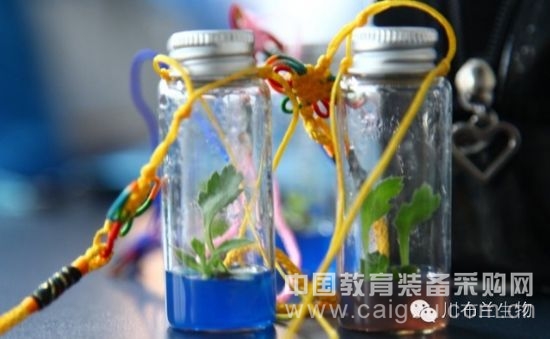Plant tissue culture is an important experiment in the new high school biology curriculum experiment. Through tissue culture, it can improve students' practical ability, scientific experiment ability, and technology promotion ability. It is also an experiment that students most want to do. However, many teachers and classmates neglected some details during the group training operation, which ultimately led to the failure of the experiment. The following is a summary of the precautions in the process of tissue training for everyone to help the teacher:
1. Preparation of culture medium
The most commonly used medium for plant tissue culture is the MS medium, which contains dozens of compounds. When preparing the medium, avoid "one pot", that is, you cannot add all the compounds together, because some compounds will encounter a chemical reaction and precipitate. It affects the nutrient composition of the culture medium. Therefore, it is necessary to wait for one ingredient to dissolve and then slowly add the other ingredient to make it a uniform, non-precipitating medium.
In addition, the pH of the medium will affect the hardness of the medium. If the pH of the medium is adjusted too high, it will make the medium harder, which will increase the resistance of inoculation and cause damage to the explants. If the pH value of the medium is adjusted too low, the medium will not be able to coagulate and will not be able to fix the explants. Therefore, the pH of the culture medium may be adjusted to 6.0.
2. Selection of explants
For successful induction after inoculation, the selected explants should be young and vigorous. Moreover, the volume of the selected explant cannot be too small. If it is too small, it will affect the formation of callus and thus affect further differentiation. Therefore, the volume of inoculated explants is generally within the range of 0.5 ~ 1.0cm2.
3. Disinfection
The disinfection of explants is mainly divided into two stages. The first is the initial disinfection, first rinse with running water, then scrub with washing powder to remove the dirt on the surface, and finally rinse with running water for 20min to complete the first disinfection. The next sterilization step should be carried out in the ultra-clean workbench. The sterilization effect of mercury in various disinfectants is the best, but because it contains heavy metals and the collection work after the experiment is not easy, it is not recommended to use liters in the middle school experiment. HG. Using alcohol for 30s, 2% ~ 10% sodium hypochlorite for 8 ~ 10min can achieve the same disinfection effect.
4. Vaccination
First, light the alcohol lamp, wipe your hands with an alcohol cotton ball, and then wipe the instrument used in the experiment, then burn it repeatedly on the flame, and set it aside until the temperature of the instrument is not high. . During the operation, to avoid the contamination of the explants with two hands passing over the petri dish, the lid of the petri dish can be covered after each trimming of the explant to reduce the contamination rate. Before inoculation, the cap of the culture medium should be quickly burned on the flame (since most schools are using plastic tissue culture bottles, it must be passed through the flame quickly to prevent damage to the tissue culture bottle) before inoculation.
5. Cultivation
The inoculated culture flask is placed on a light culture rack, and 10 hours of light is given every day to meet the light requirements of explant differentiation.
6. Refining seedlings and transplanting
Transplanting can be carried out when the sterile seedlings grow to the mouth of the tissue culture bottle. If not transplanted, it will affect the further growth of the plant and eventually lead to the death of the plant. Before transplanting, the seedlings of tissue culture should be refined first. The specific method is to close the bottle for 3 days and then open the bottle for 3 days to start the growth of bacteria on the culture medium.
Before transplanting, the root culture medium must be washed. If not washed, the nutrient content of the culture medium will increase the growth of soil microorganisms when planted in the soil, and reduce the survival rate of transplanted tissue culture seedlings. In order to improve the survival rate of tissue cultured seedlings, it can be cultivated on the sterilized perlite or vermiculite to develop the root system and then transferred to the soil.
Plant tissue culture is not as difficult as you think, as long as you pay attention to every detail throughout the operation, you will definitely reap the joy of success!

Chuan Bran Bio Official WeChat

Chuan Bran Biotechnology Official WeChat
Beijing Chuanbulan Biology- Middle School Biology Laboratory overall solution first brand, focusing on high school biotechnology laboratory, high school tissue culture laboratory, E testing laboratory, innovation laboratory, biological park and other new standard laboratory for 14 years Design, construction, instrument configuration, training and reagent supplies supply have been recognized by many prestigious schools. 7 * 24-hour national free customer service hotline, Chuan Bran official website :. Looking forward to your attention! Worry-free service experiments throughout. Chuan Bran is always your friend!

The proofing basket bottom is designed to be replaceable with different patterning,everyday you can have a different nice looking of bread.
Make the bread an ART !
Featured Bread Proofing Basket
patterned bread basket,featured bread
MIANYANG BIGANT TECHNOLOGY CO LTD , https://www.bigantech.com
![<?echo $_SERVER['SERVER_NAME'];?>](/template/twentyseventeen/skin/images/header.jpg)